
Roots
When we speak of textured hair, we are not merely observing a biological structure; we are witnessing a living archive, a profound repository of Memory and Resilience. This connection transcends the purely aesthetic, weaving itself into the very fabric of diasporic existence. For descendants of African peoples, hair is a chronicle, a silent witness to journeys across oceans and through time, a testament to survival and cultural persistence.
It speaks of ancient kingdoms, of wisdom passed through generations, and of ingenious adaptations in the face of adversity. The very coils and bends, each helix a unique marvel, carry within them the echoes of ancestral plains and the vibrant traditions that flourished there, long before the wrenching displacements of history began.
To truly understand how textured hair connects to diasporic identity and cultural preservation, we must first look to its elemental form, its inherent biological wisdom. The hair strand, in its myriad configurations, serves as a grounding point, a physical link to a shared past. It reminds us that even when external forces sought to erase a people’s heritage, something fundamental, something deeply rooted, remained.
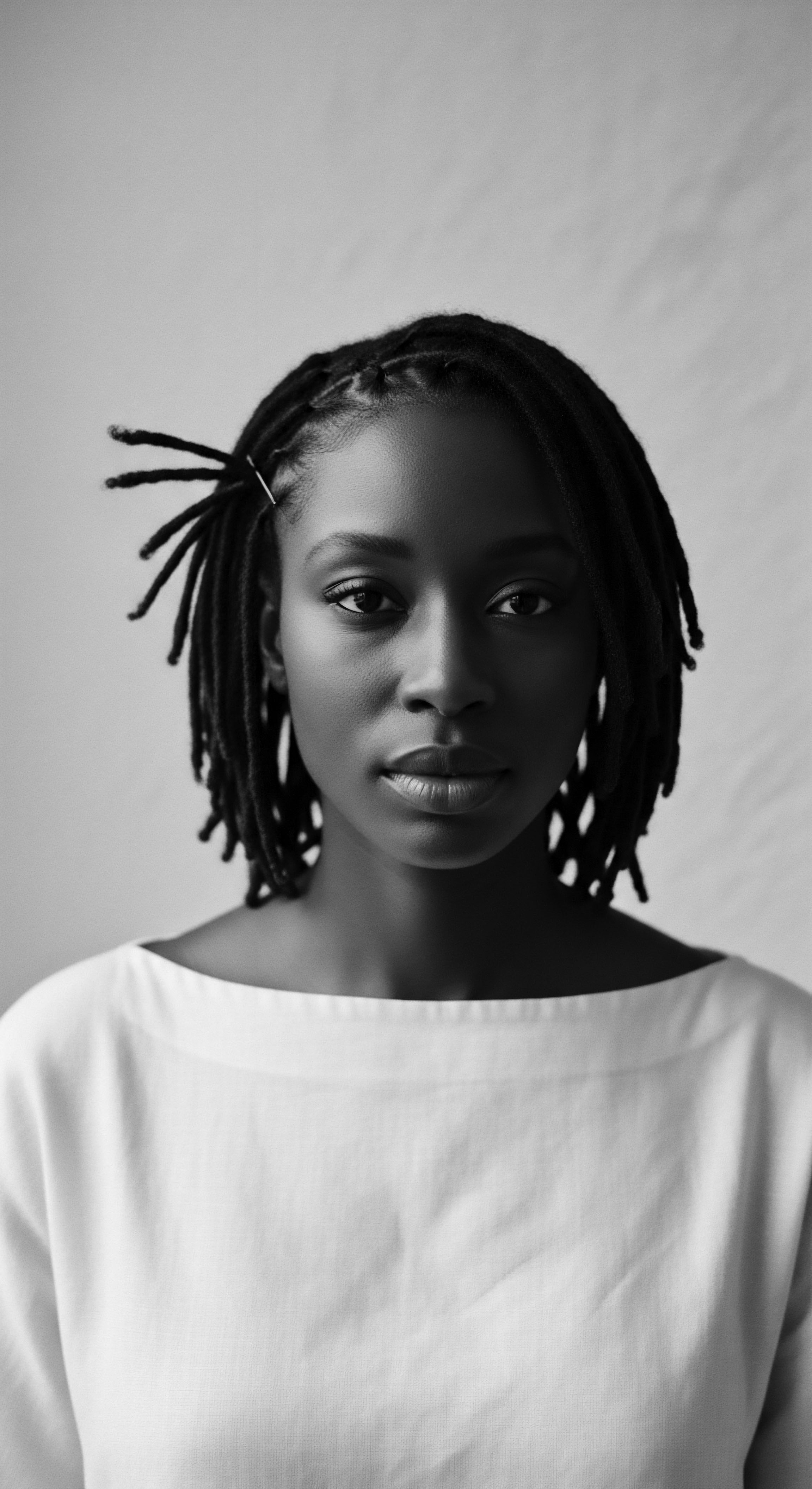
Hair’s Ancestral Architecture
The unique characteristics of textured hair begin at the follicular level. Unlike straight or wavy hair, the follicle of textured hair is often elliptically shaped, producing a strand that grows with a distinct curvature. This curvature, combined with the way keratin proteins assemble, gives rise to the familiar coil, curl, and kink patterns we observe.
These structures contribute to hair’s volume and ability to retain moisture, but also its relative fragility compared to straighter textures. This inherent design, refined over millennia within various African climates and environments, became intrinsically tied to practical applications and aesthetic expressions of cultural groups.
The intricate biology of textured hair forms a living blueprint, carrying ancestral information that shaped both form and function across generations.
In pre-colonial African societies, an understanding of hair’s inherent qualities guided care practices. The hair was a living canvas for identity, its styles conveying deep sociological meanings. For example, in many West African cultures, specific braiding patterns, adornments, and partings would signal a person’s Age, Marital Status, Social Rank, or even their Tribal Affiliation. These were not simply decorative choices; they were elaborate systems of communication, legible to those within the community.
The careful preparation of oils, butters, and herbs, derived from local flora, speaks to an ancestral science, a profound knowledge of botanical properties applied to hair’s unique needs long before modern chemistry emerged. These practices were not just about beautification; they were rituals of communal bonding, intergenerational teaching, and spiritual connection.
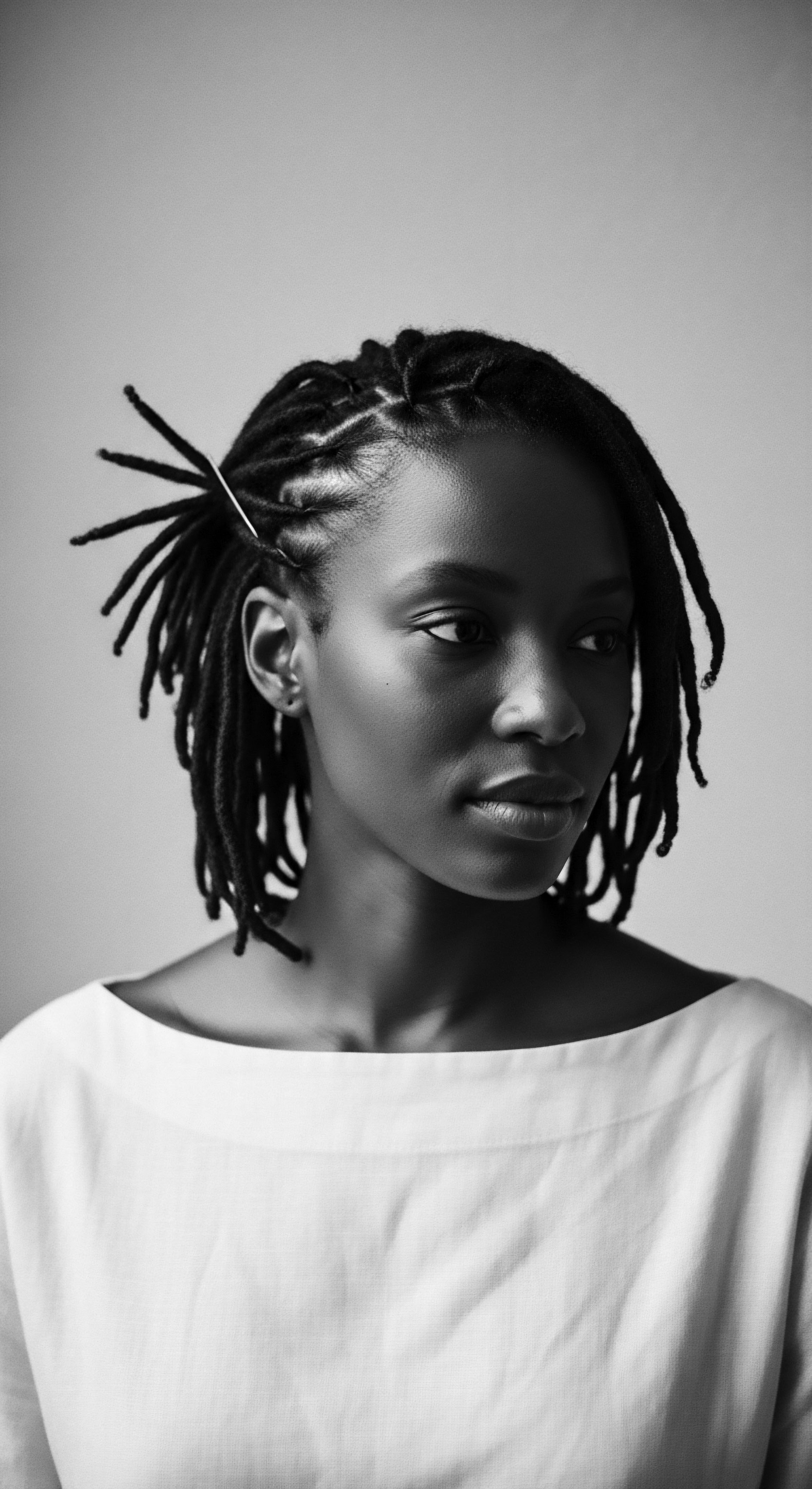
What is Textured Hair’s Basic Composition?
At its most basic, all human hair is composed primarily of keratin, a fibrous protein. However, the arrangement and bonding of these keratin chains vary significantly in textured hair. The sulfur bonds within the keratin structure contribute to the hair’s coiled shape, leading to a greater number of twists and turns along the strand.
This helical growth, while creating magnificent volume and unique aesthetic qualities, also means the natural oils produced by the scalp find it more challenging to travel down the length of the strand. This physiological characteristic underpinned many traditional care methods focused on conditioning and sealing moisture.
The very structure of a strand of textured hair reflects a profound connection to its origins. Its resilience, its ability to compress and expand, its distinct response to moisture—all these traits speak to an evolution within specific geographic and climatic contexts. This anatomical reality provides a scientific grounding for the cultural practices that arose around its care and styling.

Classifying the Coil’s Varied Expressions
Contemporary hair typing systems, like the Andre Walker system, categorize textured hair from 3A to 4C, based on curl pattern. While these systems offer a useful lexicon for modern care, it is important to understand their relatively recent origin. Historically, classification was not about a numerical grade, but about the specific cultural meanings woven into each style and the diverse regional variations. The term ‘kinky hair’ itself, once used disparagingly by colonizers to dehumanize enslaved Africans, is now being reclaimed as a descriptor of hair’s inherent beauty and strength.
Ancestral communities possessed their own sophisticated, albeit unwritten, classification systems. These systems were less about scientific measurement and more about social function and spiritual significance. A particular braid, a specific loc formation, or the application of certain red ochre pastes (as seen with the Himba people of Namibia) all served as visual markers, a language of identity understood by the community. These traditional lexicons of hair form a crucial part of the heritage of diasporic communities.
- Adire ❉ A traditional Yoruba indigo dyeing technique, sometimes reflected in hair adornments or fabrics used as wraps.
- Okute ❉ Referring to spiritual stones or charms, potentially used in ancient hair rituals or as adornments for protective purposes.
- Sankofa ❉ An Akan Adinkra symbol meaning ‘go back and get it’, symbolizing the importance of learning from the past to build the future, a principle deeply embedded in the reclamation of textured hair heritage.

Cycles of Growth and Sustenance
Hair growth follows distinct cycles ❉ anagen (growth), catagen (transition), and telogen (rest/shedding). For textured hair, the anagen phase, where hair actively grows, can be shorter than in other hair types. This can influence perceived growth rates and necessitates attention to practices that support length retention and minimize breakage. The environmental conditions of ancestral homelands—climate, available nutrients, and indigenous plant knowledge—shaped the practices that supported these natural cycles.
During the transatlantic slave trade, the deliberate act of shaving the heads of enslaved Africans upon arrival in the Americas was a profound act of cultural erasure, severing a visible link to their heritage and identity. Yet, the inherent biological capacity for growth could not be eradicated. This forced detachment from traditional hair care, and the subsequent adaptation using limited resources like bacon grease or kerosene, speaks to an incredible tenacity. This period also highlights how communities, even under immense oppression, found ways to preserve vital knowledge, often adapting to new environments.
A powerful instance of this adaptation and cultural preservation involves the enslaved West African women who ingeniously braided rice seeds into their hair before forced migration to the Americas. These hidden seeds, carried across the Middle Passage, allowed them to cultivate a staple crop in new lands, securing food for their communities, particularly the nascent Maroon Settlements. This act, small in physical scale yet monumental in its impact, underscores how deeply practical survival and cultural continuity were intertwined with hair. The act of tending to one another’s hair, even with improvised tools and ingredients, became a subtle, powerful act of communal care and cultural defiance, safeguarding a piece of their identity.
Even when forcibly removed from homelands, the inherent ability of textured hair to grow and its role in communal care became quiet acts of defiance.
The resilience of the hair itself, constantly regenerating, mirroring the spirit of a people determined to regenerate their culture, is a powerful metaphor. The challenges faced by textured hair—from moisture retention to breakage—are, in a profound way, mirrored by the historical challenges faced by the diaspora. Yet, the persistent growth, the return to its natural form, speaks to an unbreakable spirit.
| Traditional Practice/Understanding Communal hair braiding as social bonding and knowledge transfer. |
| Modern Scientific Link or Cultural Evolution Reinforces social cohesion, provides structured learning of hair art, reduces individual styling burden. |
| Traditional Practice/Understanding Use of natural plant-based oils and butters (e.g. shea, coconut) for moisture and protection. |
| Modern Scientific Link or Cultural Evolution Science confirms the occlusive and emollient properties of these ingredients, supporting moisture retention in high-porosity hair. |
| Traditional Practice/Understanding Styles indicating social status, age, or marital status. |
| Modern Scientific Link or Cultural Evolution Hair continues to be a visual identifier and expression of individual and group identity, although codes may vary. |
| Traditional Practice/Understanding Head wraps as protection and rebellion during enslavement. |
| Modern Scientific Link or Cultural Evolution Offers physical protection from elements and manipulation; serves as a powerful symbol of cultural pride and aesthetic autonomy. |
| Traditional Practice/Understanding The enduring legacy of traditional hair practices continues to shape contemporary textured hair care, validating ancestral wisdom through modern understanding. |

Ritual
Hair styling for diasporic communities extends beyond mere aesthetics; it is a sacred act, a living ritual passed down through generations. These practices connect individuals to a vast and ancient lineage, transforming the mundane into a meditative communion with ancestral wisdom. Every braid, twist, or coil formation holds whispers of history, of hands that cared for hair under vastly different skies, often in times of immense struggle. The heritage of textured hair styling is a testament to extraordinary creativity and an unbroken commitment to self-expression, even when denied the freedom to fully express one’s identity.
The very act of styling textured hair, with its unique requirements for care and manipulation, has cultivated a distinctive artistic tradition. This tradition, rooted deeply in African sensibilities, adapted and persisted through the harshest of historical realities, evolving into a complex language of visual identity.
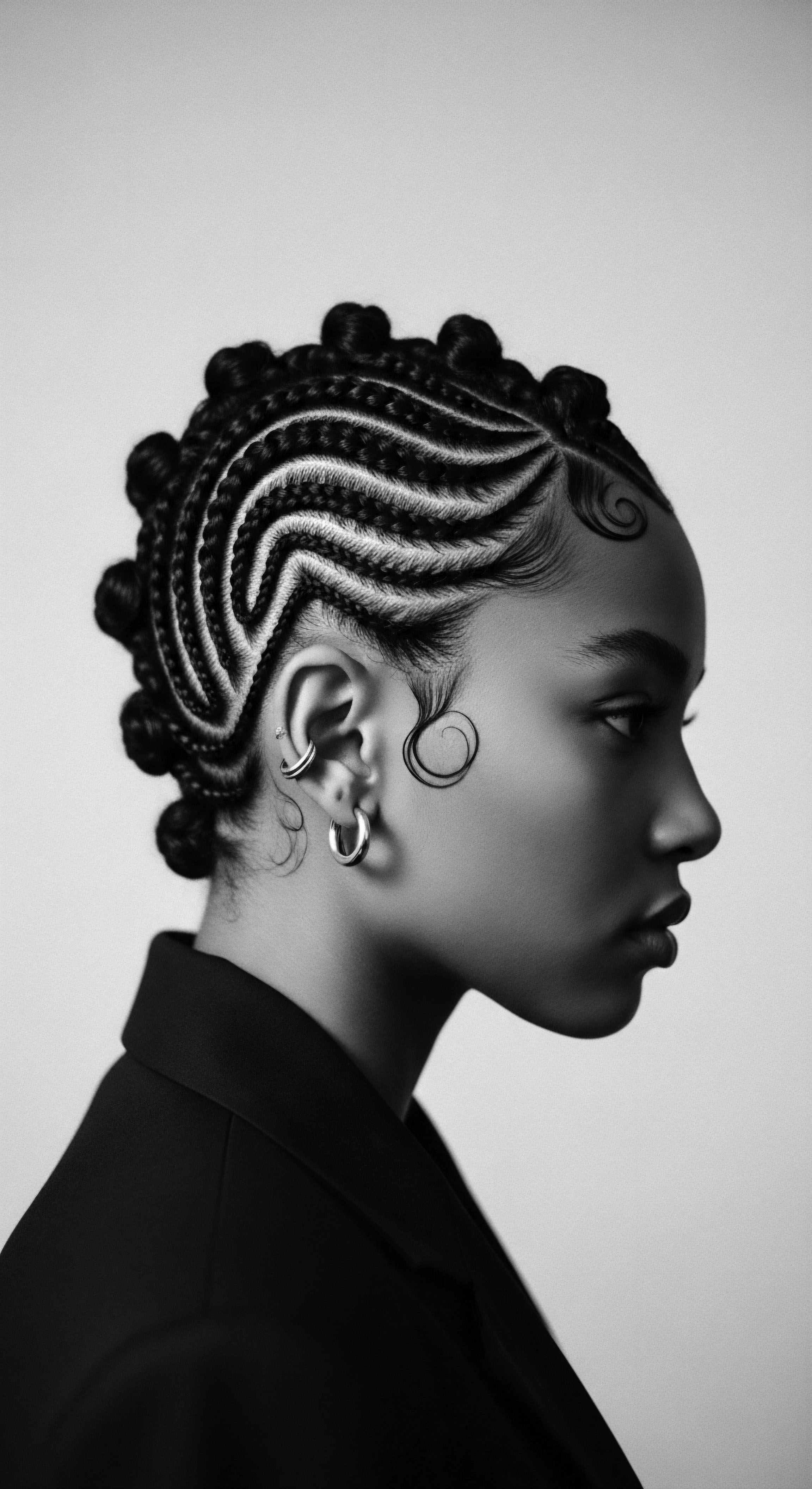
Protective Styling as Ancestral Ingenuity
Protective styles—braids, twists, cornrows, and various forms of updos—are not simply modern trends; they are direct descendants of ancient African practices. Their primary purpose has always been to safeguard the hair strand, minimizing manipulation and exposure to environmental stressors. In many ancestral communities, these styles were also crucial for practicality, allowing for ease of movement during daily tasks or for warriors in battle.
Their evolution through the diaspora is particularly compelling. During enslavement, when access to tools and products was brutally limited, and communal grooming time was scarce, styles like cornrows became essential for keeping hair contained and hygienic.
Beyond practicality, these styles became a subtle yet powerful form of resistance. The intricate patterns, deeply ingrained in the collective memory, served as a clandestine form of communication. As documented, in Colombia, enslaved individuals crafted cornrow patterns that literally mapped out escape routes and indicated safe houses, a silent cartography etched onto the scalp. This extraordinary historical example powerfully illustrates how textured hair became a dynamic tool for Survival and Emancipation, proving its profound connection to diasporic identity and cultural preservation.
This ingenuity, born of necessity and deep cultural grounding, is a powerful aspect of textured hair’s heritage. The resilience inherent in these styling methods mirrors the indomitable spirit of those who wore them.
Protective styles, born from ancestral necessity, transformed into vital tools for survival and silent resistance across the diaspora.

What Styling Techniques Carried Hidden Meaning?
The techniques used to create traditional styles were not random; they carried specific cultural meanings. For example, the direction of braids, the number of braids, or the adornments woven into them could signify a person’s readiness for marriage, their status as a healer, or their mourning period. This intricate visual grammar was a sophisticated form of non-verbal communication within tightly knit communities.
As Africans were forcibly dispersed across the globe, these techniques were adapted, often blending with new influences while retaining core elements. The continuity of braiding, twisting, and loc’ing techniques across the diaspora speaks to a powerful oral and tactile transmission of knowledge, ensuring traditions persisted despite concerted efforts to erase them.
In Jamaica, for instance, the Maroon communities, descendants of escaped enslaved Africans, fiercely retained many West African practices, including their distinctive hair braiding. The very presence of these styles in Maroon settlements served as a continuous affirmation of their cultural autonomy and resistance against colonial assimilation. This ongoing practice of traditional styling is a living link to a heritage of freedom and self-determination.
Traditional tools were often made from natural materials, such as wood, bone, or horn, carved with care and precision. These were not just instruments; they were extensions of ancestral hands, used in rituals that often involved communal grooming sessions. Such sessions were vital for fostering Social Bonds and for the intergenerational transmission of knowledge, where elders would share stories, history, and the intricacies of hair care and styling with younger generations.
The communal aspect of hair care in pre-colonial Africa, where braiding could take hours, solidified community ties and provided a context for storytelling and the preservation of oral traditions. The continuation of these communal acts, even in informal settings within diasporic communities, reinforces the idea of hair care as a shared cultural practice.

Hair’s Transformation and Reclaiming Identity
The twentieth century saw complex shifts in how textured hair was styled, often influenced by oppressive beauty standards that favored Eurocentric ideals. The widespread adoption of chemical relaxers and heat straightening tools, while offering a different aesthetic, also represented a profound detachment from the hair’s natural form and, by extension, from a visible aspect of cultural heritage. Yet, even within these choices, there was an underlying desire for aesthetic agency. The natural hair movement, gaining momentum in the mid-20th century, particularly during the Civil Rights and Black Power movements, marked a powerful reclamation.
The Afro, in particular, became a potent symbol of Pride, Resistance, and a defiant embrace of inherent beauty, challenging prevailing discriminatory norms. It was a visual declaration of identity, a rejection of forced assimilation, and a celebration of African heritage.
Today, the landscape of textured hair styling is a vibrant mosaic, blending ancient techniques with modern interpretations. We see the revival of traditional styles alongside innovative approaches that honor the hair’s natural texture. This dynamic interplay showcases the enduring adaptability and creative spirit of a people determined to define beauty on their own terms.
| Era/Context Pre-Colonial Africa |
| Traditional Tools/Materials Combs crafted from wood or bone, sharpened sticks for parting, natural oils and butters for lubrication. |
| Modern Tools/Innovations (with Heritage Link) Specialized wide-tooth combs and detangling brushes designed for textured hair, replicating gentle detangling of traditional methods. |
| Era/Context Enslavement Period |
| Traditional Tools/Materials Improvised tools ❉ coarse animal combs, butter, bacon grease for conditioning. |
| Modern Tools/Innovations (with Heritage Link) Minimal tools due to scarcity; the human hand became the primary tool, emphasizing tactile connection to hair. |
| Era/Context Post-Emancipation to Mid-20th Century |
| Traditional Tools/Materials "Hot combs" and chemical relaxers for straightening; reliance on commercial products not suited for textured hair. |
| Modern Tools/Innovations (with Heritage Link) Electric hot combs (more refined), chemical relaxers (with evolving formulations), but also a growing market for natural hair products. |
| Era/Context Natural Hair Movement Onward |
| Traditional Tools/Materials Re-emergence of traditional hand-braiding/twisting; specialized hair picks for volume; silk/satin accessories. |
| Modern Tools/Innovations (with Heritage Link) Advanced diffusers for drying curls, steam treatments for hydration, ergonomic tools that support natural hair manipulation. |
| Era/Context The evolution of hair tools reflects both periods of suppression and profound reclamation, with contemporary innovations often seeking to support the inherent characteristics of textured hair. |
The resurgence of interest in traditional techniques such as Bantu knots, two-strand twists, and various braiding styles is not simply a passing fashion. It represents a conscious decision by many within the diaspora to reconnect with their heritage, to honor the wisdom of their ancestors, and to wear their identity with pride. These styles are visual narratives, recounting a journey of survival, creativity, and the unwavering spirit of a people.

Relay
The care of textured hair extends far beyond the surface, touching upon realms of holistic wellness, spiritual practice, and the deeply personal journey of self-acceptance. In diasporic communities, these daily and nightly rituals of hair care are not merely routines; they are direct inheritances, a living relay of ancestral wisdom that speaks to the interconnectedness of body, mind, and spirit. This profound link between care practices and cultural preservation offers insights into how communities maintain continuity with their past, even in the face of persistent external pressures.
The meticulous attention given to textured hair, often perceived as high maintenance by those unfamiliar with its needs, is in truth a sophisticated dialogue with its natural attributes. This dialogue, steeped in generations of communal knowledge, forms a significant part of its heritage.

Building Personalized Hair Regimens ❉ A Legacy of Adaptation?
Creating a tailored regimen for textured hair requires a nuanced understanding of its specific needs ❉ moisture retention, gentle detangling, and protection from friction. This personalized approach mirrors the adaptable strategies employed by ancestors. In pre-colonial Africa, care was often localized, dependent on available natural resources.
Women in different regions utilized diverse plant extracts, clays, and butters unique to their environments, developing specialized techniques for application that optimized their hair’s health and appearance. This historical adaptive wisdom informs modern practices, as individuals experiment with ingredients and methods to suit their unique hair patterns and porosity.
The concept of a “regimen” in ancestral contexts was not a rigid, commercially driven set of steps but an organic, communal practice. It involved careful observation, trial and error, and the passing down of effective methods through storytelling and direct teaching. The meticulous hand-crafting of hair oils and conditioners from locally sourced herbs and plants stands as a testament to this profound Botanical Knowledge and its application in hair wellness. The very act of sharing these formulations, along with their associated rituals, ensured their preservation across generations and geographical boundaries.
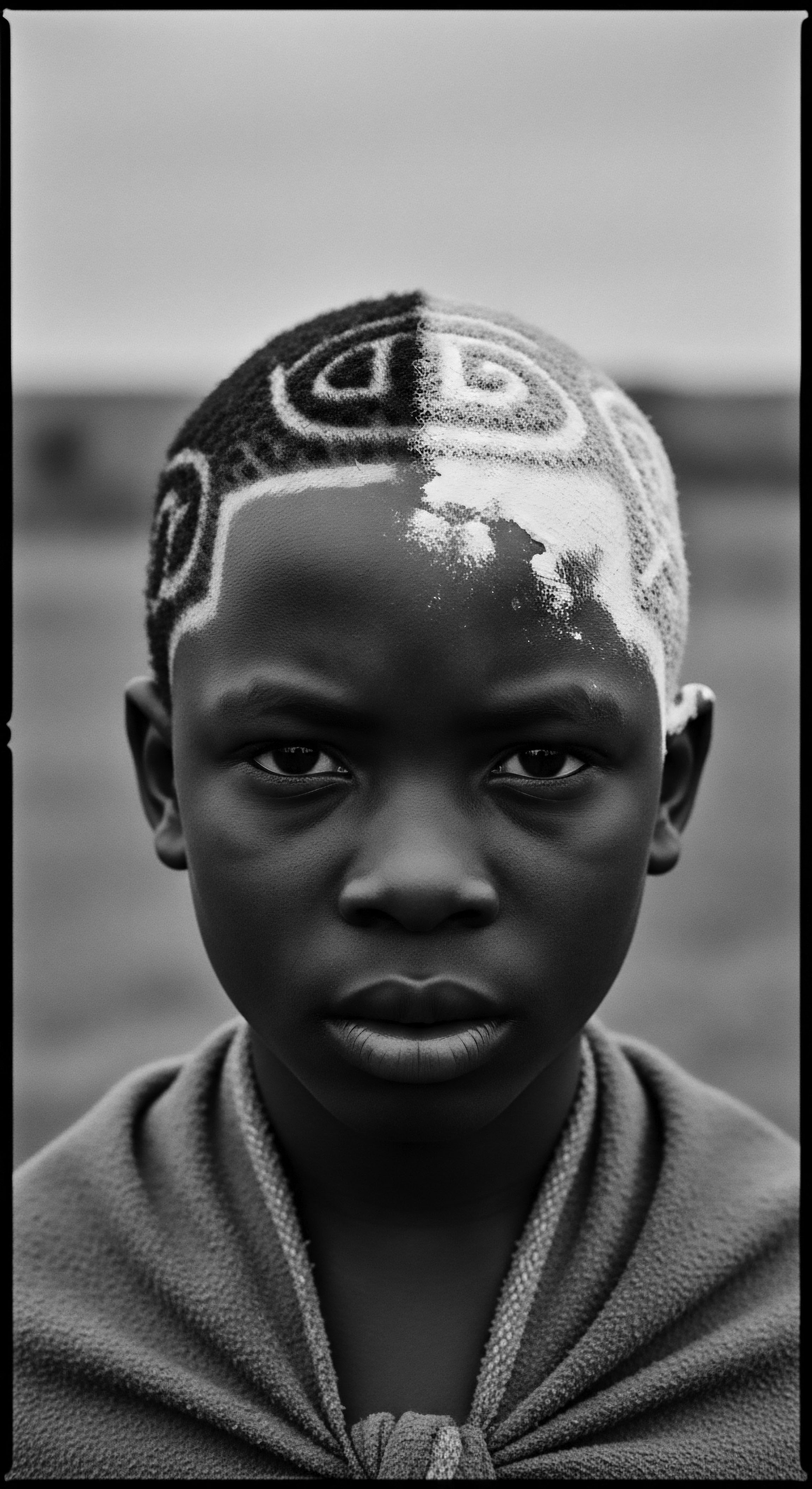
The Nighttime Sanctuary ❉ Heritage of Protection?
Nighttime hair care, particularly the use of head coverings like bonnets, scarves, and durags, holds significant cultural weight within the diaspora. While modern use often prioritizes moisture retention and frizz prevention, the historical roots of covering the head are far deeper, intertwined with notions of modesty, status, and spiritual reverence in various African cultures. During enslavement, headwraps provided practical protection from harsh working conditions and unsanitary environments. However, they swiftly became powerful symbols of dignity and resistance.
Enslaved women transformed utilitarian cloths into expressions of beauty and pride, wearing them with style and artistry even when faced with laws like the Louisiana Tignon Laws of 1786, which sought to control and diminish their visibility by mandating head coverings for Creole women of color. These laws, intended to reinforce social hierarchies, were subverted by women who adorned their tignons with vibrant colors and elaborate designs, turning an imposed regulation into a statement of cultural defiance and aesthetic autonomy.
Nighttime hair care, with its roots in protective head coverings, embodies a legacy of dignity, defiance, and cultural resilience.
The modern bonnet or silk scarf, therefore, is not simply a beauty accessory; it is a direct descendant of these historical head coverings, a continuous link to a heritage of protecting one’s crown, physically and symbolically. It represents a conscious decision to safeguard hair, a tangible connection to the ingenuity and spirit of ancestors who, against all odds, preserved cultural practices. The nightly ritual of wrapping one’s hair becomes a quiet, personal act of cultural preservation, a moment of reverence for the strands that carry so much history.

Ancestral Ingredients and Modern Needs
The efficacy of many traditional ingredients, long celebrated in ancestral care rituals, is now increasingly validated by modern scientific understanding. For example, shea butter, a staple in many West African communities, offers rich emollients that protect and moisturize textured hair. Aloe vera, utilized for centuries for its soothing properties, is now recognized for its hydrating polysaccharides. These ancestral ingredients, once applied with intuitive knowledge, represent a deep understanding of botanical science passed down through oral tradition.
The intentional re-integration of these ingredients into contemporary regimens is a powerful act of reclaiming Agency and asserting a preference for holistic, heritage-aligned care. It moves beyond simply addressing a hair “problem” to fostering a relationship with the hair that is respectful of its origins and inherent needs.
- Shea Butter ❉ A rich fatty oil extracted from the nuts of the African shea tree, historically used for its deeply moisturizing and protective qualities on hair and skin.
- Aloe Vera ❉ Valued across many traditional healing systems for its soothing and hydrating gel, providing relief for scalp conditions and moisture for hair strands.
- Black Soap ❉ Originating from West Africa, this traditional cleanser, made from plantain skins, cocoa pods, and shea butter, offers a gentle yet effective cleanse for hair and scalp.

Solving Hair Challenges with Ancestral Wisdom
Common challenges associated with textured hair, such as dryness, breakage, and tangling, have long been addressed through ancestral solutions. The consistent application of natural oils, the practice of protective styling to minimize friction, and communal detangling sessions that reduced stress on individual strands, all speak to a deep-seated knowledge of hair physics and biology, albeit expressed through cultural practices. These historical solutions were not isolated incidents but part of a continuous cycle of learning and sharing within communities.
The modern natural hair movement, a powerful current within the diaspora, represents a return to these fundamentals. It promotes a rejection of damaging chemical treatments and an embrace of techniques that respect the hair’s natural curl pattern. This movement, driven by social media and grassroots education, serves as a contemporary vehicle for cultural preservation, disseminating knowledge about textured hair care that echoes ancestral practices. Individuals share tips, product recommendations, and styling tutorials, forming a global community dedicated to celebrating their inherent hair heritage.

Holistic Influences on Hair Health
Hair health, in many ancestral wellness philosophies, was never considered in isolation. It was seen as an outward manifestation of inner well-being. Diet, stress levels, spiritual balance, and environmental factors were all understood to impact the vitality of one’s hair. This holistic perspective, often sidelined in Western approaches to beauty, is central to how textured hair connects to diasporic identity and cultural preservation.
For example, traditional diets rich in nutrient-dense, locally sourced foods contributed to strong, healthy hair. Rituals involving hair were often tied to broader spiritual practices, reinforcing the idea of hair as a sacred part of the self.
The enduring commitment to textured hair care within the diaspora is not simply about physical appearance; it is about maintaining a connection to a profound ancestral legacy. It is about honoring the resilience of those who came before, who ensured that this vital aspect of identity, this visible marker of heritage, survived against all odds. It is a quiet, continuous act of cultural affirmation, a deep reverence for the soul of each strand.

Reflection
The story of textured hair within the diaspora is not a static one, confined to history books or anthropological studies. It is a living, breathing testament to cultural continuity, an unfolding saga written in coils, kinks, and curls. Each strand, truly, holds a universe of meaning, a whispered history of journeys taken, resilience embodied, and identities defiantly held. From the elemental biology that shapes its unique form to the intricate rituals of care passed down through generations, textured hair stands as a powerful, undeniable connection to a profound ancestral heritage.
The choices made daily in styling and nurturing this hair are not trivial acts; they are threads in a vast, vibrant quilt of cultural preservation. They are acts of remembrance, of honoring the ingenuity and strength of those who, despite immense adversity, found ways to carry their essence, their knowledge, and their dignity across oceans and through time. The very act of caring for textured hair becomes a deeply personal yet universally shared experience of connection, echoing the communal grooming sessions of ancient villages and the quiet, defiant acts of solidarity in times of bondage.
This ongoing journey, with its triumphs and challenges, reminds us that identity is not lost but transformed, adapted, and celebrated. The future of textured hair care, therefore, is not merely about product innovation or stylistic trends; it is about deepening this understanding, continuing this dialogue with our past, and allowing the soul of each strand to guide us toward a more connected and authentic future. It is about recognizing that this particular hair, with its extraordinary textures and deep history, is a priceless legacy, a visible declaration of enduring spirit, and an ever-present reminder of the unbreakable ties that bind the diaspora to its ancestral heartland.
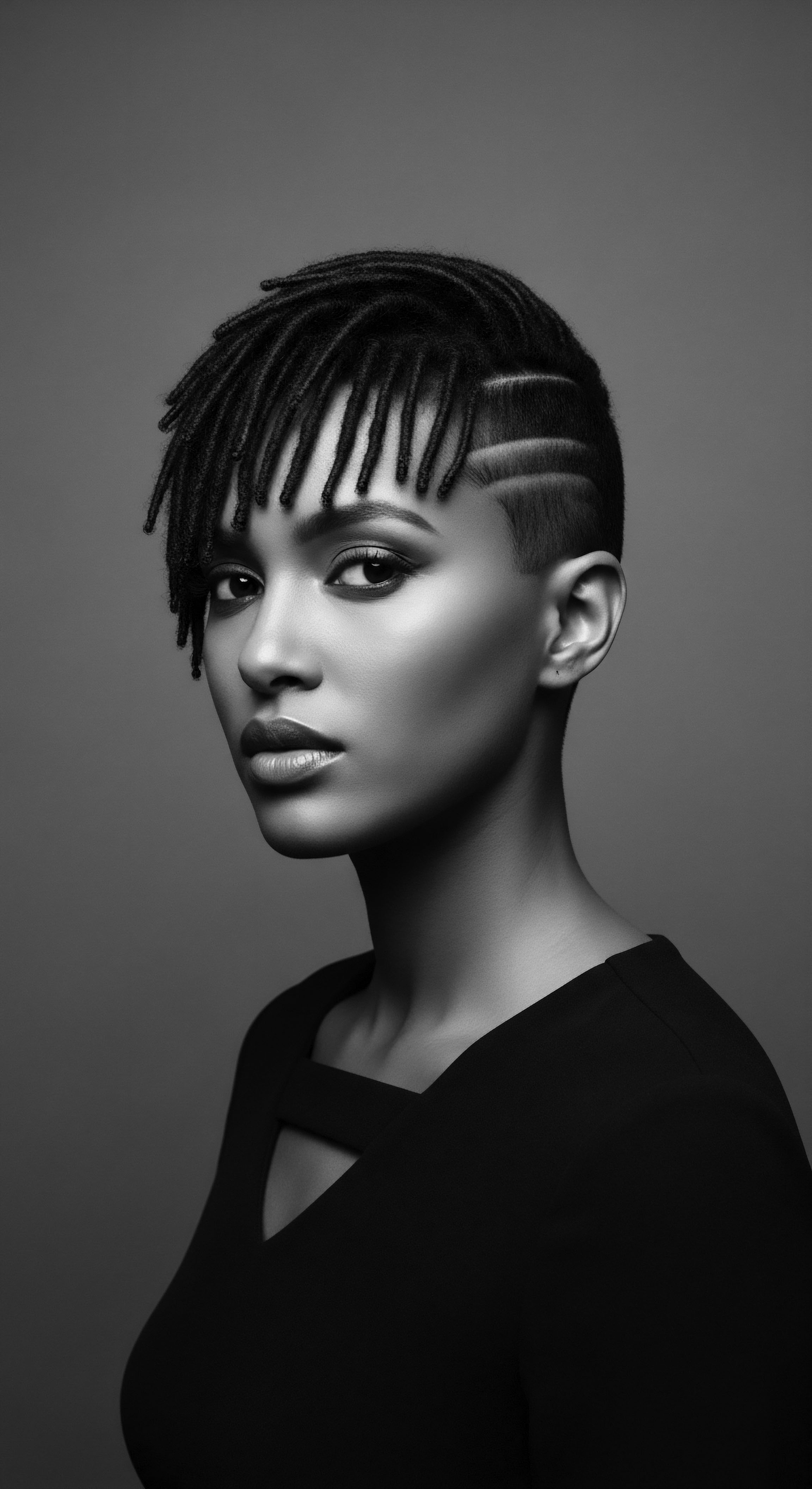
References
- Oforiwa, A. (2023). The History and Culture of African Natural Hair ❉ From Ancient Times to Modern Trends. AMAKA Studio.
- Afriklens. (2024). African Hairstyles ❉ Cultural Significance and Legacy.
- The History Of Black People Braiding Their Hair. (2023).
- NativeMag. (2020). Examining the history and value of African hair.
- Umthi. (2023). The Cultural Significance and Representation of Afro-Textured Hair.
- Ancient Origins. (2022). African Slaves Used Braids to Communicate Escape Routes in Colombia.
- Assendelft. Pre-Colonial African Hairstyles ❉ A Journey Through Time and Culture.
- Copyright. (2022). The Art of Healing ❉ A Nostalgic Ode to Black Hair Braiding.
- The Queen’s Journal. (2025). History, identity, and community ❉ The significance of Black hair.
- Odele Beauty. (2024). A History Lesson On Hair Braiding.
- OkayAfrica. A Regional Walk Through The History of African Hair Braiding.
- Nyela, O. (2021). Braided Archives ❉ Black hair as a site of diasporic transindividuation. (Unpublished master’s thesis). York University, Toronto, Canada.
- Rose, S. (2020). How Enslaved Africans Braided Rice Seeds Into Their Hair & Changed the World.
- Cultural Erasure Retention and Renewal. (n.d.). PDF.
- FroHub. (2023). Black History Month UK ❉ Celebrating Black Hair & Culture.
- Wikipedia. Discrimination based on hair texture. (n.d.).
- Van Andel, T. & Picking, D. (2022). Maroon women still grow rice varieties named after their ancestors who hid seeds in their hair when they escaped slavery in Suriname. ResearchGate.
- Scholars Crossing. (2025). Resilience and Empowerment ❉ The Impact of Gullah and Maroon Cultural Preservation on Pan-Africanism and Civil Rights Movements.
- Green, E. C. (2016). The Matawai Maroons ❉ An Acculturating Afro American Society (of Suriname).
